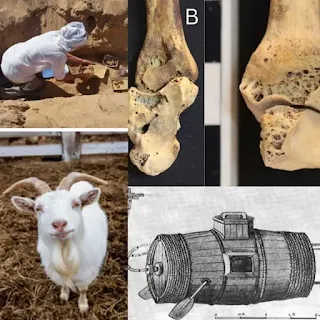Secretary General of the Supreme Council of Antiquities in Egypt, Mostafa Waziri, stressed the importance of this discovery, which is the only case of rheumatoid arthritis that has been diagnosed in ancient Egypt so far, making it one of the oldest cases in the world.
Rheumatoid arthritis is a chronic inflammatory disease that can affect areas other than the joints. This disease may destroy a wide range of body systems, including the skin, eyes, lungs, heart and blood vessels. Rheumatoid arthritis, an autoimmune disease, occurs when your immune system mistakenly attacks your body's own tissues.
Waziri pointed out that the coming period will witness many scientific research on the discovered skeleton, which is a great scientific addition and clear evidence of the presence of cases of rheumatoid arthritis in ancient Egypt, although it was only defined clinically in the seventeenth century, but archaeological evidence Historical evidence indicates the impact of the disease dating back to times earlier than the seventeenth century.
For his part, Abdel Moneim Saeed, Director General of Aswan Antiquities, said that conducting studies on the discovered structure showed that a number of joints on both sides of the body were affected, starting from the hands and feet and ending with the shoulders, elbows, wrists and ankles.
He added that the mission examined written and photographic evidence in search of signs of such a condition, but no clear text on rheumatoid arthritis has been found in ancient Egypt so far.
While Dr. Maria Carmela Gatto from the Polish Academy of Sciences, head of the mission, stated that the Aswan-Kom Ombo archaeological project aims primarily to understand and study the health conditions of the ancient Egyptians, especially those who belonged to the lower-middle classes of society, and who lived on the outskirts of the state. Ancient Egyptian, as in the far south.
Dr. Antonio Corsi from the Italian University of Bologna and deputy head of the mission said that the Aswan-Kom Ombo Archaeological Project (AKAP) has been operating since 2005 in the Aswan and Nubia archaeological area and is working on archaeological survey and documentation of prehistoric areas. It is affiliated with the mission of the Italian University of Bologna in cooperation with the Institute of Cultures. Mediterranean and Eastern - Polish Academy of Science.
In 2016, the project succeeded in detecting the first case of vitamin C deficiency in the skeleton of a young child who was found in a village dating back to the pre-dynastic period (3800-3500 BC). The discovery was published in the International Journal of Paleopathology.
A controversial study, Goats can tell whether you are happy or sad!
Researchers have found that goats can tell whether humans are happy or sad just by listening to the tone of voice.
Researchers believe that goats developed sensitivity to our vocal signals during their long association with humans, which dates back 10,000 years. It also understands physical gestures and can also tell the difference between a smile and a frown.
Author Professor Alan McElligott, from City University of Hong Kong (CityUHK), said: “This study provides the first evidence that goats can distinguish between signals expressed in human voice, namely emotional valence. These findings contribute to the limited literature available suggesting that cattle "Like pets, they are sensitive to human emotional cues."
The experiments were conducted at Buttercups Sanctuary For Goats, an animal rescue center in Button Monchelsea, Kent, where researchers used 27 male and female goats, all of which were accustomed to human voices and human interaction.
Through a loudspeaker in her barn, human voices were played of the goats saying “Hey, look here” several times, either in a happy or angry manner.
Importantly, the goats were allowed to get used to the happy sound for a period of time before the sound turned angry, or vice versa.
As expected, most of the goats looked toward the speaker when the voice changed, and spent more time staring toward the speaker when the tone of voice suddenly changed.
This suggests that the animals were able to perceive a "shift in emotional content" in human voices, the experts say in their paper, published in the journal Animal Behavior.
The team acknowledges that not all goats responded to the change in emotions, which may be due to individual differences in their cognitive abilities.
The researchers also did not notice any significant physiological changes among the goats, such as increased heart rate, after the sound changes.
However, researchers believe that goats know what two types of sounds actually mean, and not just that one is different from the other.
They also believe that negative sounds, such as the angry sounds of dogs and cats, may cause fear in goats.
In contrast, positive sounds may be perceived as soothing and may encourage animals to approach and aid in human-animal bonding.
The "Hidden Ark" was lowered into the sea 300 years ago in the presence of Emperor Peter the Great
300 years ago, the city of Petersburg witnessed a naval landing of a boat, which later became the first Russian model of a naval submarine.
It was called the "Hidden Ark", and its body was made of wood and covered with leather.
The press service of "Admiraltysky Yervy" said that the construction of the "hidden ship" began in 1720 at the "Gallery" factory (later "Admiraltysky Yervy") and ended in 1724, and it was lowered into the sea in the presence of Emperor Peter the Great.
The "hidden ship" became a model for the first Russian naval submarine, which later determined the specialty of the marine laboratory called "Admiraltysky Yervi", which later built 300 submarines and 70 civilian stations to study the depths of the sea.
Today, the “Admiralteysky Yervi” plant continues to work on building Russian military submarines, including submarines of projects “636” (Varshavyanka) and (677).


Informative
ReplyDelete